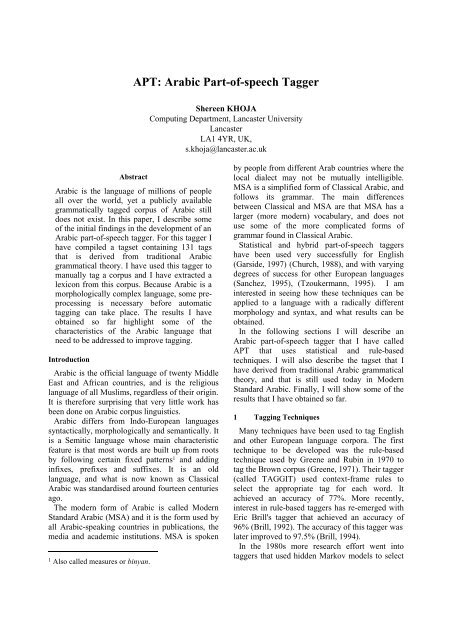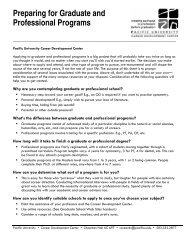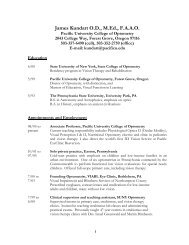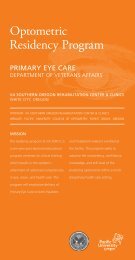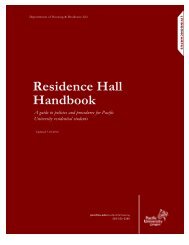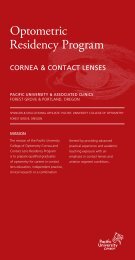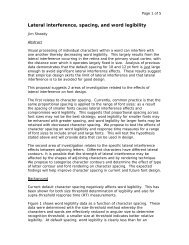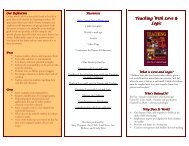APT: Arabic Part-of-speech Tagger - Computer Science
APT: Arabic Part-of-speech Tagger - Computer Science
APT: Arabic Part-of-speech Tagger - Computer Science
You also want an ePaper? Increase the reach of your titles
YUMPU automatically turns print PDFs into web optimized ePapers that Google loves.
<strong>APT</strong>: <strong>Arabic</strong> <strong>Part</strong>-<strong>of</strong>-<strong>speech</strong> <strong>Tagger</strong>Shereen KHOJAComputing Department, Lancaster UniversityLancasterLA1 4YR, UK,s.khoja@lancaster.ac.ukAbstract<strong>Arabic</strong> is the language <strong>of</strong> millions <strong>of</strong> peopleall over the world, yet a publicly availablegrammatically tagged corpus <strong>of</strong> <strong>Arabic</strong> stilldoes not exist. In this paper, I describe some<strong>of</strong> the initial findings in the development <strong>of</strong> an<strong>Arabic</strong> part-<strong>of</strong>-<strong>speech</strong> tagger. For this tagger Ihave compiled a tagset containing 131 tagsthat is derived from traditional <strong>Arabic</strong>grammatical theory. I have used this tagger tomanually tag a corpus and I have extracted alexicon from this corpus. Because <strong>Arabic</strong> is amorphologically complex language, some preprocessingis necessary before automatictagging can take place. The results I haveobtained so far highlight some <strong>of</strong> thecharacteristics <strong>of</strong> the <strong>Arabic</strong> language thatneed to be addressed to improve tagging.Introduction<strong>Arabic</strong> is the <strong>of</strong>ficial language <strong>of</strong> twenty MiddleEast and African countries, and is the religiouslanguage <strong>of</strong> all Muslims, regardless <strong>of</strong> their origin.It is therefore surprising that very little work hasbeen done on <strong>Arabic</strong> corpus linguistics.<strong>Arabic</strong> differs from Indo-European languagessyntactically, morphologically and semantically. Itis a Semitic language whose main characteristicfeature is that most words are built up from rootsby following certain fixed patterns 1 and addinginfixes, prefixes and suffixes. It is an oldlanguage, and what is now known as Classical<strong>Arabic</strong> was standardised around fourteen centuriesago.The modern form <strong>of</strong> <strong>Arabic</strong> is called ModernStandard <strong>Arabic</strong> (MSA) and it is the form used byall <strong>Arabic</strong>-speaking countries in publications, themedia and academic institutions. MSA is spoken1Also called measures or binyan.by people from different Arab countries where thelocal dialect may not be mutually intelligible.MSA is a simplified form <strong>of</strong> Classical <strong>Arabic</strong>, andfollows its grammar. The main differencesbetween Classical and MSA are that MSA has alarger (more modern) vocabulary, and does notuse some <strong>of</strong> the more complicated forms <strong>of</strong>grammar found in Classical <strong>Arabic</strong>.Statistical and hybrid part-<strong>of</strong>-<strong>speech</strong> taggershave been used very successfully for English(Garside, 1997) (Church, 1988), and with varyingdegrees <strong>of</strong> success for other European languages(Sanchez, 1995), (Tzoukermann, 1995). I aminterested in seeing how these techniques can beapplied to a language with a radically differentmorphology and syntax, and what results can beobtained.In the following sections I will describe an<strong>Arabic</strong> part-<strong>of</strong>-<strong>speech</strong> tagger that I have called<strong>APT</strong> that uses statistical and rule-basedtechniques. I will also describe the tagset that Ihave derived from traditional <strong>Arabic</strong> grammaticaltheory, and that is still used today in ModernStandard <strong>Arabic</strong>. Finally, I will show some <strong>of</strong> theresults that I have obtained so far.1 Tagging TechniquesMany techniques have been used to tag Englishand other European language corpora. The firsttechnique to be developed was the rule-basedtechnique used by Greene and Rubin in 1970 totag the Brown corpus (Greene, 1971). Their tagger(called TAGGIT) used context-frame rules toselect the appropriate tag for each word. Itachieved an accuracy <strong>of</strong> 77%. More recently,interest in rule-based taggers has re-emerged withEric Brill's tagger that achieved an accuracy <strong>of</strong>96% (Brill, 1992). The accuracy <strong>of</strong> this tagger waslater improved to 97.5% (Brill, 1994).In the 1980s more research effort went intotaggers that used hidden Markov models to select
the appropriate tag. Such taggers include CLAWS,which was developed at Lancaster University andachieved an accuracy <strong>of</strong> 97% (Garside, 1987)(Garside, 1997), Church's PARTS tagger (Church,1988) and the Xerox tagger, which was developedby Doug Cutting and achieved an accuracy <strong>of</strong> 96%(Cutting, 1992).A combination <strong>of</strong> both statistical and rule-basedmethods has also been used to develop hybridtaggers. These seem to produce a higher rate <strong>of</strong>accuracy. An accuracy <strong>of</strong> 98% has been reportedby Tapanainen and Voultilainen (1994) whenusing both techniques separately, then aligning theoutput. In fact, both Brill's tagger and CLAWS arein essence a combination <strong>of</strong> both techniques. InBrill's tagger, rules are selected that have themaximum net improvement rate that is based onstatistics, and CLAWS contains a rule-basedcomponent that handles idioms.More recently, taggers that use artificialintelligence techniques have been developed. Onesuch tagger (Daelemans, 1996) uses machinelearning, and is a form <strong>of</strong> supervised learningbased on similarity-based reasoning. The accuracyrates <strong>of</strong> this tagger for English reached 97%. Also,neural networks have been used in developing<strong>Part</strong>-<strong>of</strong>-Speech taggers. The tagger developed atthe University <strong>of</strong> Memphis (Olde, 1999) is anexample <strong>of</strong> such a tagger. It achieved an accuracy<strong>of</strong> 91.6%. Another neural network taggerdeveloped for Portuguese achieved an accuracy <strong>of</strong>96% (Marques, 1996).2 <strong>Arabic</strong> TagsetSince the grammar <strong>of</strong> <strong>Arabic</strong> has beenstandardised for centuries, I decided to derive myinitial tagset from this grammatical tradition ratherthan from an Indo-European based tagset. Thereason for this is that <strong>Arabic</strong> is a very differentlanguage from Indo-European languages, andshould have its own tagset. Also, <strong>Arabic</strong> linguistswill be basing their studies on a traditional <strong>Arabic</strong>grammar rather than an Indo-European grammar.<strong>Arabic</strong> grammarians traditionally analyse all<strong>Arabic</strong> words into three main parts-<strong>of</strong>-<strong>speech</strong>.These parts-<strong>of</strong>-<strong>speech</strong> are further sub-categorisedinto more detailed parts-<strong>of</strong>-<strong>speech</strong> whichcollectively cover the whole <strong>of</strong> the <strong>Arabic</strong>language (Haywood, 1962). The three main parts<strong>of</strong>-<strong>speech</strong>are:1. Noun: A noun in <strong>Arabic</strong> is a name or a wordthat describes a person, thing, or idea.Traditionally the Noun class in <strong>Arabic</strong> issubdivided into Derivatives (that is, nounsderived from verbs, nouns derived from othernouns, and nouns derived from particles) andPrimitives (nouns not so derived). Thesenouns could be further sub-categorised bynumber, gender and case. This class alsoincludes what, in traditional Europeangrammatical theory, would be classified as<strong>Part</strong>iciples, Pronouns, Relatives,Demonstratives and Interrogatives.2. Verb: The verb classification in <strong>Arabic</strong> issimilar to that in English, although the tensesand aspects are different. The Verb tag can besub-categorised into Perfect, Imperfect, andImperative. Further sub-categorisation <strong>of</strong> theVerb class are possible using number, personand gender.3. <strong>Part</strong>icle: The <strong>Part</strong>icle class includes:Prepositions, Adverbs, Conjunctions,Interrogative <strong>Part</strong>icles, Exceptions 2 , andInterjections.Initial experiments used a tagset that had fivemain tags (Noun, Verb, <strong>Part</strong>icle, Residual,Punctuation), which needed to be extended to 35tags taking into account clitics (see section 3). Thetagset has now been revised and contains 131 tags.These are all subcategories <strong>of</strong> the five maincategories.The verbs have been sub-categorised by ‘type’(perfect, imperfect, imperative), person, numberand gender, and the tag name reflects this subcategorisation.For example, the word ksrtm 3 “you[plural, masculine] broke”, which is a perfect verbin the second person masculine plural form, hasthe tag VPPl2M. An indicative imperfect secondperson feminine singular verb such as tktbyn “you[singular, feminine] are writing” would be taggedVISg2FI.Similarly, personal pronouns are tagged fornumber, person and gender. The tag for hma thatis a personal pronoun for the third person dualneutral (masculine or feminine) is tagged asNPrPDu3. As well as personal pronouns, there are2These include the <strong>Arabic</strong> words that are equivalent tothe word except and the prefixes non-, un-, and im-.3Words in italic are tranliterations <strong>of</strong> the <strong>Arabic</strong> word.
elative and demonstrative pronouns, which arealso classed by number and gender.Nouns are classed by number (compare ktab,ktaban, ktb, meaning “one book”, “two books”,and “books”) and gender (compare ktab[masculine] meaning “book” and mdrst [feminine]meaning “school”)). Foreign and proper nounsreceive separate tags.The category <strong>of</strong> particle includes prepositions,adverbs and conjunctions, all <strong>of</strong> which appear in<strong>Arabic</strong> either as individual words, or as cliticsattached to the following word (see section 3).Other particles are interjections, exceptions andnegative particles.Dates, numbers, punctuations and abbreviationsare also tagged separately. Dates are classified aseither an <strong>Arabic</strong> date such as mhrm which is thefirst month in the Islamic calendar, or a date fromthe Gregorian calendar such as atar which is the<strong>Arabic</strong> word for the month “March” 4 .3 The Training Corpus and LexiconA corpus <strong>of</strong> 50,000 words in Modern Standard<strong>Arabic</strong> (an extract from the Saudi Al-Jazirahnewspaper, date 03/03/1999) was tagged using thesmaller tagset described above, and is currentlybeing retagged with the more detailed tagset.For morphologically complex words acombination <strong>of</strong> tags was used. For example, theword walktab “and the book” is given the tagPC+NCSgMND, where PC indicates a particlethat is a conjunction, and NCSgMND indicates asingular, masculine, nominative, definite noun.This corpus was used to derive the variouslexicons described below. It was also used to trainthe tagger; that is, to extract the statistical data thatis needed for the automatic tagging <strong>of</strong> untagged orraw corpora (see section 4.4).The first version <strong>of</strong> the lexicon lists every wordthat appears in the training corpus together with allthe tags it has received. Because <strong>of</strong> the frequentoccurrence <strong>of</strong> clitics in <strong>Arabic</strong>, many wordsappear in the lexicon several times with differentclitics. For example, the word mstsfat “hospital”appears twice in the lexicon, once with the definitearticle, and once without.4Some <strong>Arabic</strong> texts use a transcription <strong>of</strong> the Englishmonths. For example, March transcribed in <strong>Arabic</strong> asmars.An example <strong>of</strong> a clitic in English would be“she'll”, where two words have been mergedtogether, “she” and “will”. In <strong>Arabic</strong> the definitearticle, equivalent to “the” in English, appears as atwo-letter proclitic at the beginning <strong>of</strong> the noun.This is similar to the definite article in Frenchthat appears as a proclitic when attached to a wordthat starts with a vowel. An example is l'idée,where l' is the definite article, and idée is theFrench word for “idea”. Another example <strong>of</strong> aclitic is the Italian word muoviamoci “let us go”.The clitic here is the first person plural pronoun ci.Similarly the conjunction “and” appears in<strong>Arabic</strong> as a one-letter proclitic attached to the firstword <strong>of</strong> the coordinated sequence; this word couldbe a noun (including a noun with prefixed definitearticle), a verb, particle or even a number. Other<strong>Arabic</strong> clitics include further inseparableconjunctions, pronouns, and some prepositions.For the second version <strong>of</strong> the lexicon, the cliticsare removed from the words before they areplaced in the lexicon. This allows a rule-basedcomponent <strong>of</strong> the tagger to match the un-cliticisedword in the lexicon to the word in the runningtext, whatever clitics it is encountered with. In theoriginal lexicon derived from the training corpus,for instance, the ambiguous <strong>Arabic</strong> word marsappears without any clitics meaning the foreignmonth name “March”, and also with theconjunction “and” to mean the verb “and hepracticed”.The initial version <strong>of</strong> the lexicon containing allwords from the corpus without removing anyclitics contained 13,912 words. After removingclitics, the lexicon was reduced to 9,986 words.Table 1 shows an extract from the lexicon. Thefirst column contains a transcription <strong>of</strong> the <strong>Arabic</strong>word, the second column contains its meaning,and the other columns contain all that words tags.This small extract from the lexicon highlightsthe fact that the lexicon does not cover all thepossible tags <strong>of</strong> some words. For example, the<strong>Arabic</strong> word hrs appears in the corpus onlymeaning the noun “guards”, but more generally itcould also be the verb “he guarded”. Anotherexample is the word hsn that appears three timesin the training corpus as a proper noun, but it doesnot appear in the training corpus with its othermeaning “good”. It will be necessary in the futureto go through the lexicon and manually add all thepossible tags to each word, or use a larger training
corpus, thought that might still not find allpossible tags.thml carrying, carry VISG2M VISG3Ftwjyhat instructions NPLFkadm servant NSGM?qd convene, contract VPSG3MNSGMhrmyn mosques [dual] NDUMsryfyn distinguished [dual] NDUMmustsfa hospitalNSGFan truly, not, letter N P PS NFmtnql mobile NSGMadwyt medicines NPLFila to PPSahd one, Sunday NSGM NDnql move(V), move(N) VPSG3MNSGM?ly Ali(name), on NP PPSt?ml doing VISG2M VISG3Fhrs guard NPLMhsn Hassan(name) NPTable 1: Extract from the lexicon4 The <strong>Arabic</strong> POS <strong>Tagger</strong><strong>APT</strong> was developed using a combination <strong>of</strong> bothstatistical and rule-based techniques since hybridtaggers seem to produce the highest accuracy rates(see section 1).4.1 Initial TaggingThe first step <strong>of</strong> the tagger is the initial tagging.This is basically the look-up component <strong>of</strong> thetagger. Here every word is looked up in thelexicon, and if it is found, then it is given all thepossible tags <strong>of</strong> that word as specified in thelexicon.In early versions <strong>of</strong> the tagger, clitics would bestripped <strong>of</strong>f words in the running text before lookupin the lexicon, but this is now incorporated inthe more general morphological analysis describedin the section 4.2.Since the lexicon is so small, the initial look-upis unlikely to find many <strong>of</strong> the words. Most <strong>of</strong> thewords that it would find might be particles and ifthe text is from the same genre, then maybe some<strong>of</strong> the proper nouns and verbs.It is obvious then that because <strong>of</strong> <strong>Arabic</strong>'scomplex morphology, some pre-processing ormorphological analysis is required. This isachieved by using the stemmer.4.2 StemmingStemming is the process <strong>of</strong> removing all <strong>of</strong> aword's affixes to produce the stem or root. In<strong>Arabic</strong> this means the removal <strong>of</strong> prefixes,suffixes and infixes. The stemming component isthe rule-based part <strong>of</strong> the tagger, since rules areused to determine what the affixes are.After the initial tagging, if a word is not found inthe lexicon, it is stemmed. The affixes are used tohelp determine the tag <strong>of</strong> the word. Sometimesone affix can determine the tag <strong>of</strong> a word: forexample, if the prefix is the definite article, thenthe word is a noun. On the other hand, acombination <strong>of</strong> affixes is most commonly used todetermine the tag <strong>of</strong> the word. For example, if theprefix is a t “which indicates the imperfect verb”and the suffix is wn “which indicates themasculine plural”, then the word is likely to be asecond person plural masculine imperfect verb,such as tdrswn which means “you [pluralmasculine] are studying”.Since the stemming algorithm also uses the<strong>Arabic</strong> word patterns, these can be used todetermine the tag <strong>of</strong> the word. Most words in<strong>Arabic</strong> are formed using fixed patterns, and thesepatterns have predictable properties and meanings.For example, words that follow a certain patternare plural nouns. This type <strong>of</strong> plural is called thebroken plural, and it is different from the sound orperfect plural because it is not formed by thesimple addition <strong>of</strong> suffixes.Some <strong>of</strong> the problems that the stemmer faces arethat some letters that appear to be affixes are infact part <strong>of</strong> the word. Another problem is thatsome letters (for instance the long vowels) maychange to other letters when an affix is added, andso the letters should be changed back when thataffix is removed.Tests <strong>of</strong> the stemmer over <strong>Arabic</strong> words showthat it achieves an accuracy <strong>of</strong> 97%, using adictionary <strong>of</strong> 4,748 triliteral and quadriliteralroots.4.3 Results after Initial TaggingFour corpora were compiled and used for testing.The corpora were chosen because they are fromdifferent countries, and although they all useModern Standard <strong>Arabic</strong>, some local colloquialdifferences do appear. The last corpus was chosen
probabilities that were calculated can be seen inTable 2. Here, the probability <strong>of</strong> a Noun beingfollowed by another Noun is 0.711, and theprobability <strong>of</strong> a Verb being followed by a Noun is0.926.N V P No. Pu.N 0.711 0.065 0.143 0.010 0.071V 0.926 0.037 0.0 0.008 0.029P 0.689 0.199 0.085 0.016 0.011No. 0.509 0.06 0.098 0.009 0.324Pu. 0.492 0.159 0.152 0.046 0.151Table 2: Contextual Probabilities <strong>of</strong> Tagged CorpusThe statistical tagger achieved an accuracy <strong>of</strong>around 90% when disambiguating ambiguouswords with this tagset. On the other hand, thetagger tagged all unknown words as nouns. Thereason for this is that over 30,000 words (67%) inthe training corpus were nouns, so the probability<strong>of</strong> a word being a noun is much higher than theprobability <strong>of</strong> it being anything else.ConclusionI am currently recalculating the lexical andcontextual probabilities that will be used by thetagger for the larger tagset. The results <strong>of</strong> thestatistical tagger will be presented in the nearfuture.Another improvement that is necessary here is togo through the lexicon manually and add all thepossible tags that a word can take.A component that still needs to be added is apre-processing component to handle commonerrors found in <strong>Arabic</strong>. These include the errors inthe placement <strong>of</strong> the hamza on the alif (glottalstops), and also placing the dots under the letteryah. An example <strong>of</strong> such an error can be seen inTable 1, where the name ali should have the dots,while the preposition meaning “on” should nothave the dots.ReferencesRoger Garside, Ge<strong>of</strong>frey Leech, and Anthony McEnery(1997) Corpus Annotation: Linguistic Informationfrom <strong>Computer</strong> Text Corpora. Addison WesleyLongman Inc., New York.Kenneth Church (1988) A Stochastic <strong>Part</strong>s Programand Noun Phrase Parser for Unrestricted Text. In“Proceedings <strong>of</strong> the Second Conference on AppliedNatural Language Processing” (ACL) Austin, Texes,pp. 136-143.Fernando Sanchez Leon and Amalio F. Nieto Serrano.(1995) Public Domain POS <strong>Tagger</strong> for Spanish.CRATER Final Deliverable Report No. 22.Evelyne Tzoukermann, Dragomir R. Radev, andWillian A. Gale (1995) Combining LinguisticKnowledge and Statistical Learning in French <strong>Part</strong><strong>of</strong>-SpeechTagging. In EACL SIGDAT Workshop.Association for Computational Linguistics -European Chapter, Dublin, Ireland.B.B. Greene and G.M. Rubin (1971) AutomaticGrammatical Tagging <strong>of</strong> English. Department <strong>of</strong>Linguistics, Brown University, Providence, R.I.Eric Brill (1992) A Simple Rule-Based <strong>Part</strong> <strong>of</strong> Speech<strong>Tagger</strong>. In “Proceedings <strong>of</strong> the Third Conference onApplied Natural Language Processing”, Trento, Italy,pp. 152-155.Eric Brill (1994) Some Advances in TransformationBased <strong>Part</strong> <strong>of</strong> Speech Tagging. In “Proceedings <strong>of</strong>the Twelfth International Conference on ArtificialIntelligence” (AAAI-94), Seattle, WA.Roger Garside, Ge<strong>of</strong>frey Leech, and Ge<strong>of</strong>frey Sampson(1987) The Computational Analysis <strong>of</strong> English: acorpus-based approach. Longman Group UKLimited.Doug Cutting, Julian Kupiec, Jan Pederson, andPenelope Sibun (1992) A Practical <strong>Part</strong>-<strong>of</strong>-Speech<strong>Tagger</strong>. In “Proceedings <strong>of</strong> the Third Conference onApplied Natural Language Processing”, Trento, Italy.Pasi Tapanainen and Atro Voutilainen (1994) Taggingaccurately - Don't guess if you know. In “Proceedings<strong>of</strong> the Fourth ACL Conference on Applied NaturalLanguage Processing”, Stuttgart.Walter Daelemans, Jakub Zavrel, Peter Berck, andSteven Gillis (1996) MBT: A Memory-Based <strong>Part</strong> <strong>of</strong>Speech <strong>Tagger</strong>-Generator. In “Proceedings <strong>of</strong> theFourth Workshop on Very Large Corpora”,Copenhagen, Denmark, pp. 14-27.Brent A. Olde, James Hoener, Patrick Chipman, ArthurC. Graesser, and the Tutoring Research Group (1999)A Connectionist Model for <strong>Part</strong> <strong>of</strong> Speech Tagging.In “Proceedings <strong>of</strong> the 12th International FloridaArtificial Intelligence Research Society Conference”,Menlo Park, CA, pp. 172-176.Nuno Marques and Jos Gabriel Lopes (1996) UsingNeural Nets for Portuguese <strong>Part</strong>-<strong>of</strong>-Speech Tagging.In “Proceedings <strong>of</strong> the Fifth International Conferenceon The Cognitive <strong>Science</strong> <strong>of</strong> Natural LanguageProcessing”, Dublin City University.JA Haywood and H M Nahmad (1962) A new <strong>Arabic</strong>grammar. Lund Humphries Publishers Ltd.F. Jelinek (1976) Continuous Speech Recognition byStatistical Methods. In “Proceedings <strong>of</strong> the IEEEE”,pp. 532-556.


